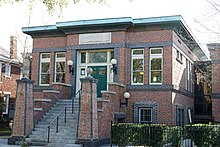
Dublin is a city in Laurens County, Georgia, United States. As of the 2020 census, the city had a population of 16,074. It is the county seat of Laurens County.

A Carnegie library is a library built with money donated by Scottish-American businessman and philanthropist Andrew Carnegie. A total of 2,509 Carnegie libraries were built between 1883 and 1929, including some belonging to public and university library systems. 1,689 were built in the United States, 660 in the United Kingdom and Ireland, 125 in Canada, and others in Australia, South Africa, New Zealand, Serbia, Belgium, France, the Caribbean, Mauritius, Malaysia, and Fiji.

Houston Public Library is the public library system serving Houston, Texas, United States.

The Atlanta–Fulton Public Library System is a network of public libraries serving the City of Atlanta and Fulton County, both in the U.S. state of Georgia. The system is administered by Fulton County. The system is composed of the Atlanta Central Library in Downtown Atlanta, which serves as the library headquarters, as well as the Auburn Avenue Research Library on African American Culture and History, and 33 branch libraries.
Dana Albert "D. A." Dorsey (1872–1940) was a businessman, banker, and philanthropist who became one of the first African–American millionaires in Florida and the American South.
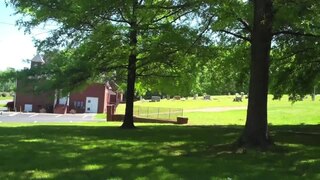
The Rosenwald School project built more than 5,000 schools, shops, and teacher homes in the United States primarily for the education of African-American children in the South during the early 20th century. The project was the product of the partnership of Julius Rosenwald, a Jewish-American clothier who became part-owner and president of Sears, Roebuck and Company and the African-American leader, educator, and philanthropist Booker T. Washington, who was president of the Tuskegee Institute.
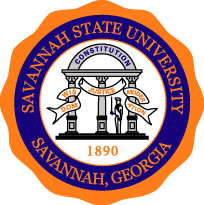
Savannah State University is a public historically black university in Savannah, Georgia. It is the oldest historically black public university in the state. The university is a member-school of the Thurgood Marshall College Fund.

The Jackson Zoo is a zoo that was established in 1919 in Jackson, Mississippi and exhibits over 120 species and approximately 250 individual animals, providing the public the opportunity to observe and study wildlife from around the world and region. The Jackson Zoo is in the historic 110-acre (0.45 km2) Livingston Park and welcomes approximately 85,000 visitors annually from Mississippi and surrounding states. 20,000 school children make their way to the zoo throughout the school year.

The Savannah Victorian Historic District is a historic district in Savannah, Georgia. It is mostly residential in character and features Late Victorian, Queen Anne, and other architectural styles.

Hill Hall at Savannah State College, also known as Walter Bernard Hill Hall and built between 1900 and 1901 by students studying manual arts and blacksmithing, was added to the National Register of Historic Places in 1981. The building was named for Dr. Walter Barnard Hill.

Prairie Avenue is a north–south street on the South Side of Chicago, which historically extended from 16th Street in the Near South Side to the city's southern limits and beyond. The street has a rich history from its origins as a major trail for horseback riders and carriages. During the last three decades of the 19th century, a six-block section of the street served as the residence of many of Chicago's elite families and an additional four-block section was also known for grand homes. The upper six-block section includes part of the historic Prairie Avenue District, which was declared a Chicago Landmark and added to the National Register of Historic Places.
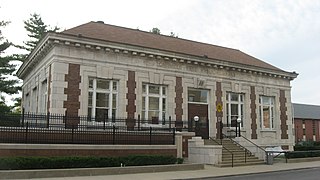
The Louisville Free Public Library's Western Branch or Western Library is a public library in Louisville, Kentucky. It is a Carnegie library and is the first public library built for African Americans staffed entirely by African Americans. Previously known as Louisville Free Public Library, Western Colored Branch, and registered as a historic site in that name, it is a branch of the Louisville Free Public Library system. It is listed on the National Register of Historic Places.
The Carnegie Branch Library at 13th St and 28th Ave in Meridian, Mississippi is one of two former Carnegie libraries in the city, both funded by a grant from Andrew Carnegie in 1904. This library was built for blacks while the other was built for whites. The other library was built at 25th Ave and 7th St and now houses the Meridian Museum of Art. Both buildings were listed on the National Register of Historic Places in 1979. The black library was demolished in 2008.

The Bethel A.M.E. Church, known in its early years as Indianapolis Station or the Vermont Street Church, is a historic African Methodist Episcopal Church in Indianapolis, Indiana. Organized in 1836, it is the city's oldest African-American congregation. The three-story church on West Vermont Street dates to 1869 and was added to the National Register in 1991. The surrounding neighborhood, once the heart of downtown Indianapolis's African American community, significantly changed with post-World War II urban development that included new hotels, apartments, office space, museums, and the Indiana University–Purdue University at Indianapolis campus. In 2016 the congregation sold their deteriorating church, which will be used in a future commercial development. The congregation built a new worship center at 6417 Zionsville Road in Pike Township, Marion County, Indiana.

The Live Oak Public Libraries are a consortium of sixteen public libraries in the Savannah metropolitan area and Hinesville – Fort Stewart metropolitan area of Georgia, United States. The library provides services for Chatham County, Effingham County, and Liberty County. The library headquarters are located in the Bull Street Library in Savannah, which is one of two Carnegie libraries in the system.
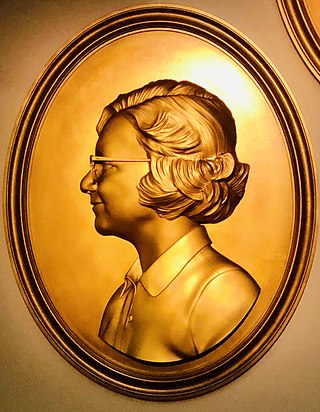
Clermont Huger Lee was a landscape architect from Savannah, Georgia, most known for her work designing gardens and parks for historical landmarks in the state. Specifically, Lee is known for her designs such as the Juliette Gordon Low Birthplace, Isaiah Davenport House and Owens-Thomas House. Lee assisted in founding of the Georgia State Board of Landscape Architects which serves as a licensing board for landscape architects throughout Georgia. She is considered one of the first women to establish their own private architecture practice in Georgia and was inducted into the Georgia Women of Achievement in 2017 and Savannah College of Art and Design's Savannah Women of Vision on February 14, 2020. SCAD honors Lee with a gold relief in its Arnold hall.
The African American Cultural Heritage Action Fund is a program formed in 2017 to aid stewards of Black cultural sites throughout the nation in preserving both physical landmarks, their material collections and associated narratives. It was organized under the auspices of the National Trust for Historic Preservation. The initiative which awards grants to select applicants and advocates of Black history has been led by architectural historian Brent Leggs since 2019. It is the largest program in America to preserve places associated with Black history.
